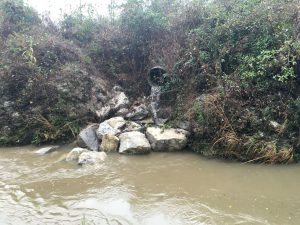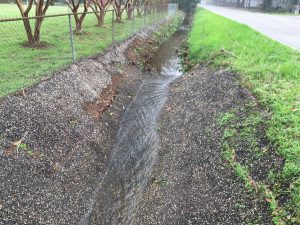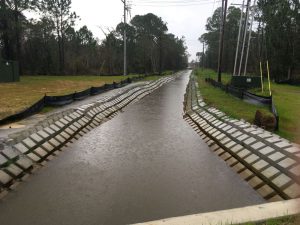Urbanization—the process of conversion from forests, grasslands, or agricultural fields to predominantly residential, commercial, and industrial settings—can cause profound changes to the pathways that rainfall takes to become streamflow. This landscape conversion leads to less water infiltrating into soil and more water running directly into streams and other nearby water bodies (such as lakes, wetlands, and bayous). Urban water runoff carries pollutants that have accumulated on the landscape and in soil since the previous rainfall. If the concentrations of pollutants in streams are large enough, they can cause problems for the organisms that live in streams as well as those in the bays and bayous those streams flow into (often called receiving waters).
Local governments play a key role in mitigating the impacts of urbanization on aquatic ecosystems. In northwest Florida, County government is often responsible for limiting pollutant inputs from the network of surface and underground stormwater conveyances known as “municipal separate storm sewer systems” (abbreviated as MS4s). The United States EPA requires urban areas to be regulated as sources of pollutant discharge through their National Pollutant Discharge Elimination System (abbreviated NPDES); departments within Escambia County and Santa Rosa County government coordinate the administration of these permits with the US EPA.
The requirements of these MS4 water quality permits vary depending on the population of the area. Permits for medium and large cities or counties having populations greater than 100,000 are categorized as “Phase I” MS4s, while areas with smaller populations are categorized as being “Phase II” MS4s. These two categories have many similar requirements, but also have a few important differences. Permits for both types of MS4s require local agencies to develop methods for community outreach on stormwater pollution issues, controlling runoff from construction sites, and requiring stormwater management in new developments. In addition to the requirements listed above, Phase I MS4s require the implementation of a water quality monitoring program and a plan to reduce pollutants from developed areas.
In Spring 2020, the southern portion of Santa Rosa County transitioned from a Phase II MS4 region to Phase I. This means that Santa Rosa County will begin implementation of a surface water monitoring program to evaluate pollutant concentrations in stormwater conveyances (including creeks); and develop plans for reducing pollutants from their MS4s entering the Pensacola Bay System. This program will make important contributions to understanding the effects of urban development on our local streams and estuaries, and improve water quality in the Pensacola Bay System.
This is a great opportunity to remind us of the importance of disposing our personal protective equipment including face masks, plastic gloves, and other single-use items we use to protect ourselves from the coronavirus in the trash after use. Leaving it on the curb or in parking lots means that it can wash into stormwater ponds or creeks and bayous, which can cause problems for the animals that live there.
- Nature-Based Stormwater Solutions in the Florida Panhandle - July 14, 2023
- Urbanization and MS4s in Stormwater - May 8, 2020
- Green Infrastructure can Reduce Flooding and Improve Water Quality in the Florida Panhandle - March 13, 2020



